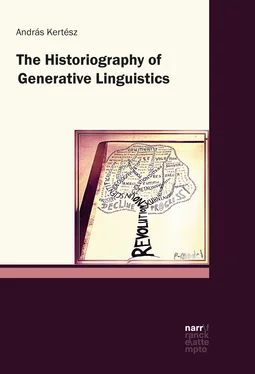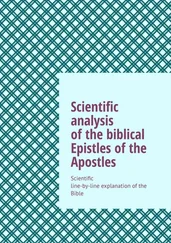Thus, HarrisHarris, Randy Allen provides the following solution to (P):
| (SP11) |
The basic terms of the historiographyhistoriography of generative linguistics with respect to Syntactic Structures Syntactic Structures and Aspects Aspects are ›rhetoric‹rhetoric and ›linguistics war‹, its central hypothesis is (T11) and its framework is postmodern psychological, sociologicalsocial and rhetorical analysis. |
2.2 ›Aspects Aspects of the Theory of Syntax‹ (ChomskyChomsky, Noam 1965)
2.2.0 Background information
In between the appearance of Syntactic Structures Syntactic Structures and his next influential book, Aspects Aspects of the Theory of Syntax , ChomskyChomsky, Noam published his review of SkinnerSkinner, B.F.’s (1957) Verbal Behavior . The main characteristics of the review are as follows:
ChomskyChomsky, Noam launched a fierce attack on behaviorismbehaviorism which had also been presupposed in BloomfieldianBloomfieldian and neo-Bloomfieldianneo-Bloomfieldian linguistics.
He argued for his assumption that verbal behavior (in the sense of behaviorismbehaviorism) cannot be understood without understanding grammargrammar (as a mental capacity).1
At the same time, he was one of those who initiated the treatment of grammargrammar as the result of mental processes, thus contributing to what came to be known in the 1960s as mentalismmentalism and later as cognitivismcognitive.2
He drew an analogy between the native speaker’s knowledge of grammargrammar and the linguist’s scientificscientific knowledge of grammar, and assumed that the former can be treated as a theorytheory as well.3
In this review he also maintained that grammargrammar should be capable of explaining how the child acquires the grammar of her languagelanguage.4
Aspects Aspects of the Theory of Syntax carried on central insights of the review and by integrating further findings it became what, according to BoeckxBoeckx, Cedric (2006: 17), »arguably remains to this day the clearest statement of the generative enterprise as a whole«. This work put forward the following main ideas:
The »fundamental distinction between competence (the speaker-hearer’s knowledge of his languagelanguage) and performance (the actual use of language in concrete situations)« was introduced (ChomskyChomsky, Noam 1965: 4; emphasis as in the original).
The object of investigation is the ideal speaker-hearer’s competence.5
The grammars of particular languageslanguage are supplemented by universal grammargrammar.6
The grammargrammar includes a semantic, a phonological and a syntactic component. The semantic and the phonological component are purely interpretive . Then, »the syntactic component of a grammar must specify, for each sentencesentence, a deep structure that determines its semantic interpretation and a surface structure that determines its phonetic interpretation. The first of these is interpreted by the semantic component; the second, by the phonological component.« (ChomskyChomsky, Noam 1965: 16; italics as in the original)
The deep structure is constituted of a set of basic phrase markers. »In addition to its base, the syntactic component of a generative grammargrammar contains a transformationaltransformation subcomponent. This is concerned with generating a sentencesentence, with its surface structure, from its basis.« (ChomskyChomsky, Noam 1965: 17)
The central problem is that of languagelanguage acquisition as already raised in the review of SkinnerSkinner, B.F.’s book. Aspects Aspects specifies this problem by introducing the term ›language acquisition device‹.7 The latter is a theoretical construct referring hypothetically to a tool that helps children acquire the grammargrammar of their language, starting from what is called ›primary linguistic datadata‹ (i.e. the data available to the child during language acquisition) and resulting in the correct grammar of that language. The linguist’s task is to explain this process.8 Thereby, the difficulty is that no inductiveinductive procedure can explain how a child succeeds in acquiring a grammar of high complexity in a very short time.9 Therefore, it is to be assumed that the child has already innate universal predispositions that enable her to select the correct grammar compatible with the primary linguistic data.10
Grammars should be evaluated by three standards, called levels of adequacy. A grammargrammar is observationally adequate if it correctly accounts for the datadata which are the input to languagelanguage acquisition. A grammar is » descriptively adequate to the extent that it correctly describes the intrinsic competence of the idealized native speaker« (ChomskyChomsky, Noam 1965: 24). Finally, it is explanatorily adequate if it explains how the child arrives at her grammar on the basis of linguistic evidence she observes in language acquisition.11
In the 1960s a heated debate took place between ChomskyChomsky, Noam and a group of his disciples, primarily George LakoffLakoff, George, John R. RossRoss, John R., James D. McCawleyMcCawley, James D. and Paul PostalPostal, Paul M., on the status of semantics in grammargrammar. The latter questioned the interpretive role of semantics as indicated above, and instead regarded semantics as the generative component of grammar. They argued for another model of grammar in which surface structures are derived from semantic structures. Thus, deep structure seemed to be, for them, no well-motivated component of the grammar. Eventually the generative semanticssemanticsgenerative movement fell apart and Chomsky’s position retained dominance.
2.2.1 KuhnianKuhnian revolutionrevolutionKuhnian
Although it follows from NewmeyerNewmeyer, Frederick J.’s (1986b), KoernerKoerner, E.F. Konrad’s (1989), (2002), (2004), MurrayMurray, Stephen O.’s (1980), (1994), (1999a), SeurenSeuren, Pieter A.M.’s (1998) and HarrisHarris, Randy Allen’s (1993a) claims that the appearance of Syntactic Structures Syntactic Structures did not trigger a KuhnianKuhnian scientificscientific revolutionrevolutionscientific in linguistics, it does not follow that later stages of generative linguistics could not have been revolutionaryrevolutionary. As early as the 1970s consideration was given to the assumption that it was Aspects Aspects (ChomskyChomsky, Noam 1965) that bore revolutionary characteristics in the Kuhnian sense rather than Syntactic Structures. Thus the next thesis is the following:
| (T12) |
It was Aspects Aspects of the Theory of Syntax that triggered a scientificscientific revolutionrevolutionscientific in linguistics and led to the birth of a new paradigm.paradigm |
McCawleyMcCawley, James D. (1976: 4–5) argues for this thesis by making reference to three factors:
By the mid-sixties, the number of adherents of generative transformationaltransformation grammargrammar – originally a small minority of linguists – had greatly increased.
Generative transformationaltransformation grammargrammar developed from an avantgarde movement into a leading and institutionalized field.
The nature of generative publications had significantly changed. While at the end of the 1950s and at the beginning of the 1960s, they were primarily motivated by polemics against neo-Bloomfieldianneo-Bloomfieldians, after the appearance of Aspects Aspects they became more research-oriented by systematically focusing on constructive investigations.
According to McCawleyMcCawley, James D., the first two factors amount to a scientificscientific revolutionrevolutionscientific, and the third indicates the beginning of normal sciencesciencenormal in KuhnKuhn, Thomas S.’s sense. However, he does not discuss further indications of KuhnianKuhnian revolutionrevolutionKuhnians.
Читать дальше












